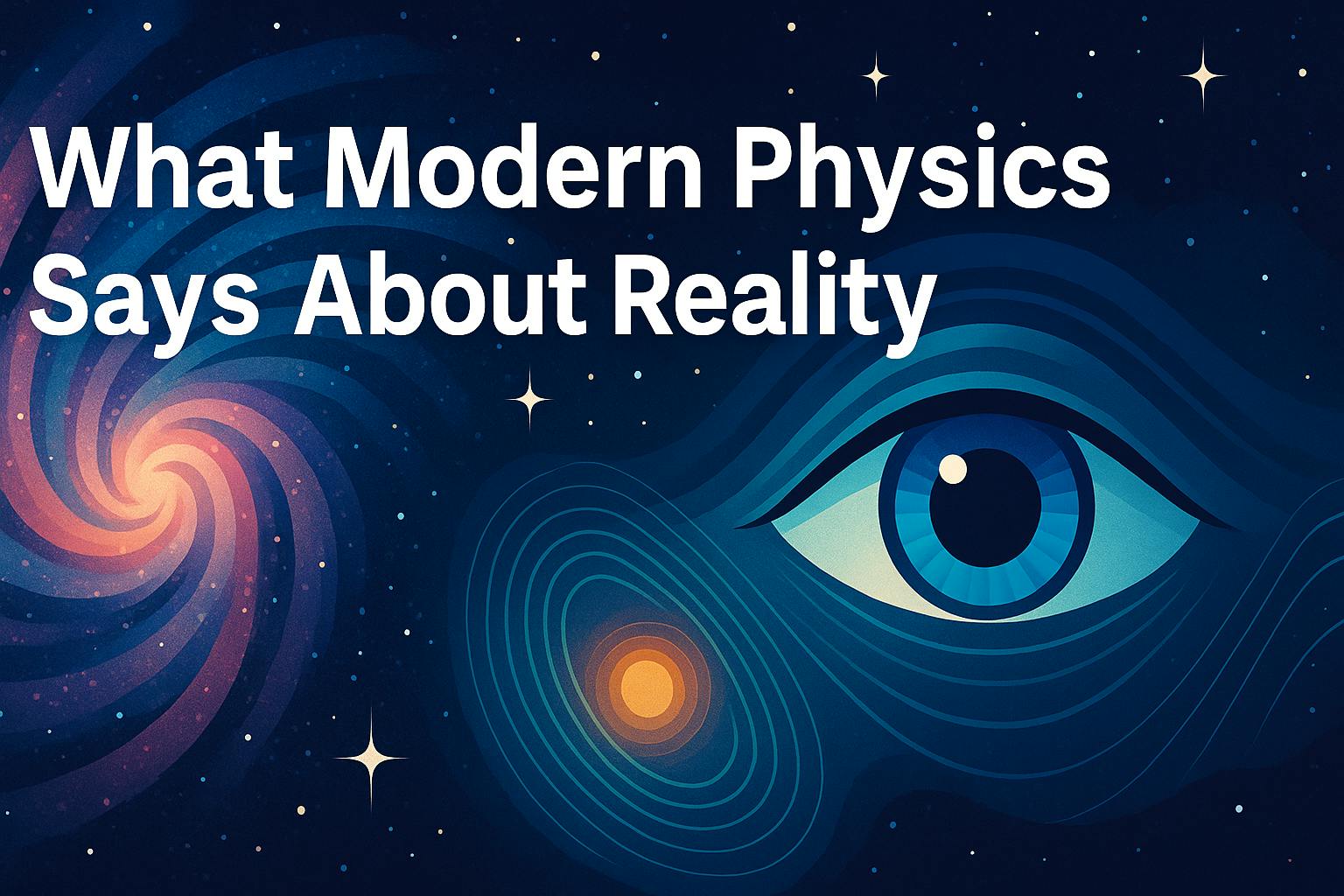One of humanity’s most fundamental desires is to understand how the reality surrounding us works. For a long time, we were making good progress. The worldview of classical physics in the 19th century was still clear and comprehensible. The Universe resembled a finely tuned machine, governed by elegant laws that could be described using relatively simple mathematics. Only a few phenomena stood out as exceptions—anomalies that classical physics couldn’t explain.
According to an often-told anecdote, when Max Planck decided to pursue a career in physics, a mentor advised him against it, claiming that almost everything worth discovering had already been found. Ironically, it was Planck himself who helped trigger the avalanche that eventually brought down the beautiful cathedral of classical physics, replacing it with something strange and modern—neither elegant nor simple.
In this article, I aim to provide a brief overview of how modern physics views the world today.
According to our current scientific understanding, the Universe is a vast, continuously expanding sphere composed of spacetime. And here, “spacetime” is not just an abstract concept, but a real, physical entity. It’s somewhat akin to the 19th-century idea of the ether—something that fills everything, even the regions that appear to be empty. In fact, Einstein himself once referred to spacetime as a “gravitational ether” in one of his writings. To avoid misunderstandings, perhaps it would have been better to keep that term. In that case, we might say the Universe is a vast, ever-expanding ether-sphere. But now that we’ve clarified that, we’ll stick with the official term: spacetime.
Spacetime has an intimate relationship with matter—matter affects spacetime, and spacetime affects matter. Specifically, matter causes spacetime to curve around it, and in curved spacetime, matter moves as if some invisible force were pulling on it. This is what we perceive as gravity. Another consequence of spacetime curvature is that physical processes slow down in the vicinity of massive objects. Elementary particles remain stable longer, physical and chemical reactions slow down, and even people age more slowly. In this sense, time itself slows down near large masses.
Given this close relationship between matter and spacetime, it’s tempting to imagine matter as simply another manifestation of spacetime—as if matter were made of tiny bubbles or condensations within the spacetime fabric. This perspective can help explain why we seem “trapped” within our spacetime, and thus within our Universe. A “spacetime condensation,” by its very nature, cannot exist outside of spacetime. Questions like “What is outside the Universe?” or “What happened before the Universe began?” are therefore meaningless from this viewpoint.
That said, there have been attempts to build theoretical models in which matter is interpreted as such distortions or concentrations of spacetime—but so far, no fully functional theory has emerged. Part of the difficulty lies in the interference from quantum mechanics. The picture described above is what the Theory of Relativity shows us about the Universe. It describes gravity and spacetime quite well—but when it comes to matter, especially at the smallest scales, its explanations fall short.
Let’s now take a look at what the other great theory—quantum mechanics—has to say about the world. While it doesn’t have much to say about spacetime or gravity, it describes the behavior of matter with astonishing precision, all the way down to its smallest building blocks: elementary particles.
Most of us learned in school that the smallest unit of matter still retaining the properties of a chemical element is the atom. Atoms consist of a nucleus surrounded by an electron cloud. The nucleus itself is made up of protons and neutrons, which in turn are composed of quarks. According to current knowledge, quarks and electrons are elementary particles, meaning they are not made up of anything smaller. But what, exactly, is an elementary particle?
We currently know of four fundamental interactions that can act between particles: gravity, electromagnetism, the weak nuclear force, and the strong nuclear force. Any information we obtain about a particle comes through one of these four interactions, each mediated by its own type of field.
Imagine an electron along with the fields that surround it. Now, imagine that these fields were to suddenly vanish. What would happen to the electron? Since we could no longer detect it in any way, it would effectively cease to exist. In fact, there are already particles in nature that are nearly undetectable—neutrinos, which interact only via the weak force. Billions of them pass through the Earth—and through our bodies—every second without us noticing a thing. Even if we placed a wall of lead one light-year thick in their path, about half of them would still pass through untouched. Detecting them requires massive neutrino detectors, where extremely rare, faint flashes of light signal a neutrino interaction. These particles, in a sense, “barely exist.” If they didn’t even participate in the weak interaction, they would cease to exist entirely, for all practical purposes.
Now imagine the reverse: we remove the particle but leave its fields intact. Would anything change? Since all of our measurements are based on interactions, it would still appear as if the particle were there. If we used these fields to construct atoms, and from those, macroscopic objects like a rock, that rock would behave just like a real one. We could see it, touch it, and measure it. In this view, point-like particles may not be necessary at all. We might just as well consider particles as regions of space with special properties.
This idea is formalized in what is currently the most successful theory of physics: quantum field theory (QFT). According to QFT, every type of elementary particle is associated with a corresponding quantum field—an electron field, a photon field, and so on. What we think of as “particles” are really just excitations in these fields, and the interactions between particles arise from the way these fields influence each other.
To visualize this, imagine a field as the surface of a body of water, and particles as ripples or waves on that surface. Of course, it’s not quite that simple—these fields are quantized, which means they only respond to energy inputs of a very specific amount. For example, you can only excite the electron field if the energy matches exactly the mass of an electron. Any less, and nothing happens. But apply the right amount, and an “electron wave” appears.
QFT helps explain many phenomena intuitively. For example, when an electron and a positron (its antiparticle) meet, what actually happens is that a positive and a negative wave in the electron field cancel each other out. The resulting energy then excites the photon field, creating two photons.
Quantum field theory resolves the famous wave–particle duality of quantum mechanics by doing away with the particle picture entirely. Everything is waves. The classic double-slit experiment illustrates this beautifully.
When an electron is emitted from a source, what’s actually emitted is a disturbance in the electron field. As it approaches the two slits, the wave spreads out and interferes with itself. It then reaches the wall behind the slits. There, the electron field interacts with the wave patterns of electrons in the atoms making up the wall. A random interaction occurs, triggering a chemical reaction—and a visible dot appears on the screen. Because these interactions are point-like, it seems in experiments as if we’re dealing with particles. But according to QFT, particles as such don’t exist—only fields do.
QFT currently provides the most accurate description we have of the physical world, yielding predictions that match experiments with extraordinary precision. But there’s one major problem: it’s not compatible with general relativity. The all-pervading quantum fields resemble the 19th-century ether—much like spacetime in relativity does—but the properties of these two “ethers” are fundamentally different. When we try to merge them into a single theory, contradictions arise.
Still, many physicists are working on this unification, and numerous candidates have emerged—string theory, loop quantum gravity, twistor theory, and several others.
Before talking about these theories, it’s worth introducing the concept of the Planck units, since nearly every attempt at a unified theory relies on it. Based on Heisenberg’s uncertainty principle and a few other physical constants, one can calculate the smallest possible length scale at which information can, even theoretically, be obtained. This is known as the Planck length. Distances smaller than this simply do not exist in any physically meaningful way, because we have no means of detecting anything on such scales. Similarly, there is a Planck time, the smallest meaningful unit of time.
This leads to an intriguing idea: perhaps spacetime has a discrete or “atomic” structure—or, to use a more modern analogy, it’s made up of finite-size “pixels.” What makes this notion especially exciting is that these unreachable scales become a kind of hiding place for unresolved theoretical issues. The Planck scale is to theoretical physicists what that one locked room is to the owner of a beautiful, well-kept house—the place where all the clutter and chaos is hidden away from view.
Take string theory, for example. It proposes that there is only one fundamental object in the universe: the superstring, and its vibrations determine which particle is present. One frequency corresponds to a photon, another to an electron, and so on. It’s an extraordinarily elegant theory—one in which the Universe resembles a grand cosmic symphony.
But there’s a catch: the mathematics requires not just 3 spatial dimensions, but 9. Of course, everyday experience tells us we only perceive 3. So where are the remaining 6 dimensions? The answer is that they are compactified—curled up into spaces smaller than the Planck length, which is why we don’t notice them. Problem solved.
How elegant or satisfying this solution feels is, of course, a matter of personal taste.
We have every reason to believe that there exists a grand unified field theory—one that would reduce all particles, all interactions, gravity, and even the structure of spacetime itself to a single underlying framework. Perhaps this ultimate theory will be based on a medium similar to the old concept of the ether, with the properties of this medium determining how the entire Universe behaves. But for now, such a theory remains out of reach.
One more point I’d like to highlight is the inaccuracy of our mental models. It sounds appealing, for example, to compare quantum fields to the surface of a body of water, with elementary particles as the waves—but we mustn’t forget that this is just a metaphor, and a rather imprecise one at that. Quantum field theory (QFT) offers no real answers to the deeper mysteries of quantum mechanics. It remains nonlocal, and the enigmatic collapse of the wavefunction is still present.
True, instead of waves collapsing into particles, QFT speaks of point-like interactions, but the core question remains: what causes the collapse, and why does it happen in one place and not another? As a result, the strange interpretations of quantum mechanics—like the many-worlds hypothesis or retrocausal effects that move backward in time—still exist within QFT. Nonlocality remains, too: the wavefunction of an entangled particle system can stretch across light-years, only to collapse instantaneously in a single interaction.
So, the deeper we dig into QFT, the further we drift from the intuitive image of ripples on a water surface. And if we truly want to see things clearly, without being misled by flawed analogies, we’re left with just one tool: mathematics.
Ultimately, the most accurate model of the world resembles a vast computation. We come closest to reality when we imagine the Universe as a giant set of states, undergoing continuous computation—each moment transforming the system into a new state. Pure information and processing. Those who resonate with the simulation hypothesis may envision this as an actual computer, built by someone “out there,” running our world as a program. Others, who believe we inhabit the one true objective reality, might say that the world itself is the computer.
Whatever the case may be, one thing is certain: the deeper we venture down the rabbit hole, the more we must confront the fact that the Universe is far, far stranger than we ever imagined.











